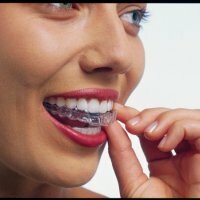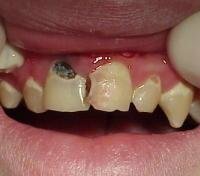Advantages and disadvantages of veneers
 Today, every person can become the owner of the Hollywood smile. Medicine does not stand still and every year in dentistry there are various procedures, systems and lining for the teeth, which make it possible to make the smile unsurpassed.
Today, every person can become the owner of the Hollywood smile. Medicine does not stand still and every year in dentistry there are various procedures, systems and lining for the teeth, which make it possible to make the smile unsurpassed.
If a person does not like the color of tooth enamel, the dentist whitens his teeth. If a person has an incorrect bite or twisted teeth, then they put a bracket system. If the teeth are chipped or damaged, the doctor can offer veneers. Veneer is a small plate that is superimposed on the front of the tooth. Using veneer, you can improve the appearance of the front teeth.
For the first time, veneers appeared in the US in the early 20th century. Dentist Charles Pincus developed them in order that in a short time you could correct the curvature and yellowness of teeth in Hollywood stars who aspired to an ideal smile. However, at that time veneers were a temporary measure. They were superimposed only for a couple of days. Modern veneers are attached to the teeth for several decades.
Correcting tooth defects with
veneers Veneers are sometimes called microprostheses. Due to them it is possible to hide various defects of teeth: crevices between teeth, small chips, irregularities and yellowness. Externally, the veneer is like a thin petal in the shape of a tooth.
To date, there are two varieties of veneers. Therapeutic veneers are made on the tooth itself. The cover is made of a composite material, which is similar to a filling material. Such veneers are installed if the tooth is damaged by 60% or more. For several stages, the dentist restores the tooth, and then fixes the veneer on it. Sometimes it is necessary to grind the top layer of the enamel to put the microprosthesis.
Orthopedic or Hollywood veneers are produced in the dental workshop on the impression of the patient's restored tooth. Various materials are used for the production of such veneers: ceramics, medical alloys. Finished petals are fixed on the tooth enamel with a special glue.
The most modern are lumineers. They are made of high-strength materials and very expensive. However, they are much thinner than simple veneers and when installing them, it is unnecessary to grind dental enamel. Lumineers are produced by a topographic image of a patient's teeth in special laboratories.
What you need to know about therapeutic veneers:
- You can recommend such veneers to a dentist if the patient has chipped teeth or small irregularities.
- Composite materials from which such veneers are made are presented in a narrow color range, so sometimes it is not possible to precisely match the color to the natural color of tooth enamel.
- Some people choose inexpensive therapeutic veneers. However, they are more fragile and have a porous structure, due to which they can be colored from drinks and food.
- Therapeutic veneers will cost much less than a ceramic crown. What you need to know about orthopedic veneers:
- These veneers are designed to improve the aesthetic appearance of teeth. They are very similar in color to the natural enamel of the tooth, so they let in the light and do not stand out from the rest of the teeth.
- If a person is engaged in extreme sports, opens cork with his teeth, snaps nuts and the like, then it is better to refuse such veneers. Instead of them, strong dentures are suitable.
- If a person suffers from bruxism, then before installing the veneers you need to consult an orthopedist. He will make a protective cap for the teeth, which must be worn for the night.
- When installing such veneers tooth enamel is grinded. The doctor polishes half a millimeter of the top layer of the enamel, so in the future you need to constantly monitor the health of your teeth and prevent the loss of veneers.
- Porcelain veneers can last up to eight years, and lumineers can last up to twenty.
- To ensure that the veneers have served their due, we must carefully look after the tooth enamel.
- If desired, veneers can be removed in the dental office. However, the enamel will be unprotected, which can lead to the development of caries and increased sensitivity of teeth. The veneer itself is attached to the tooth on dental glue, which contains a lot of fluoride. Fluoride is very useful for teeth and absolutely safe.
Advantages and disadvantages of
veneers There are many ways to restore teeth. However, veneers, in comparison with them, have a lot of advantages:
- In the manufacture of porcelain veneers, impermeable materials are used, so that they do not form stains. Even if a person regularly drinks coffee, there are coloring products, the veneers will not change their original color.
- Veneers maximally provide a natural look to the teeth. When light enters the tooth enamel, it does not immediately reflect, but penetrates into the enamel layer. A few dozen years ago, for the manufacture of veneers used other materials that did not provide such naturalness due to the fact that they were much denser and opaque. Porcelain veneers and lumineers are transparent, so they give such an effect.
The main disadvantages of veneers are their fragility. Of course, on average, the service life of the veneer is about 10-15 years. However, veneers can break down, after which they can not be restored. After the breakdown of the veneer, you need to install a new one, which will cost a lot.
Sometimes the veneer disappears entirely. In this case, you can return it. However, if it has cracks or chips, it can not be restored. The cost of veneers is high, and not everyone can afford them.
When it is not possible to install veneers
Not all dentists take up the installation of veneers. They are contraindicated to establish if a person has toothache or weakened tooth enamel. Also, they can not be set with bruxism, straight bite, and when not all teeth are cut.
Microprostheses made of porcelain are not installed on teeth damaged by caries and with gum disease. Therefore, with such problems, first you need to cure your teeth and gums, and only then you can install the veneers.
Microprostheses are not installed if most of the tooth is destroyed by caries or if the tooth is broken or there is a seal in it. In such cases, doctors are looking for another way to restore the tooth, for example - crowns.
Dentists do not recommend installing veneers for people who are used to strongly clenching their teeth and grinding them.
How to extend the service life of veneers
Do not put more pressure on the teeth when wearing veneers. If the patient wants to keep the veneers intact, he should forever give up such habits as nibbling his nails, cracking nuts and the like. Even it is not recommended to bite off too strong food.
Veneers do not tolerate high acidity very well. Therefore, you should try to use as little as possible products with high acidity. Also some types of veneers can be painted, so you should avoid products that paint veneers( coffee, berries, tea).
Careful care is required when wearing dental veneers. After all, if hygiene is poor, caries can develop under the veneer. In this case, the veneer will have to be changed. For veneers, teeth should be cleaned two to three times a day. Dentists recommend using an irrigator.



